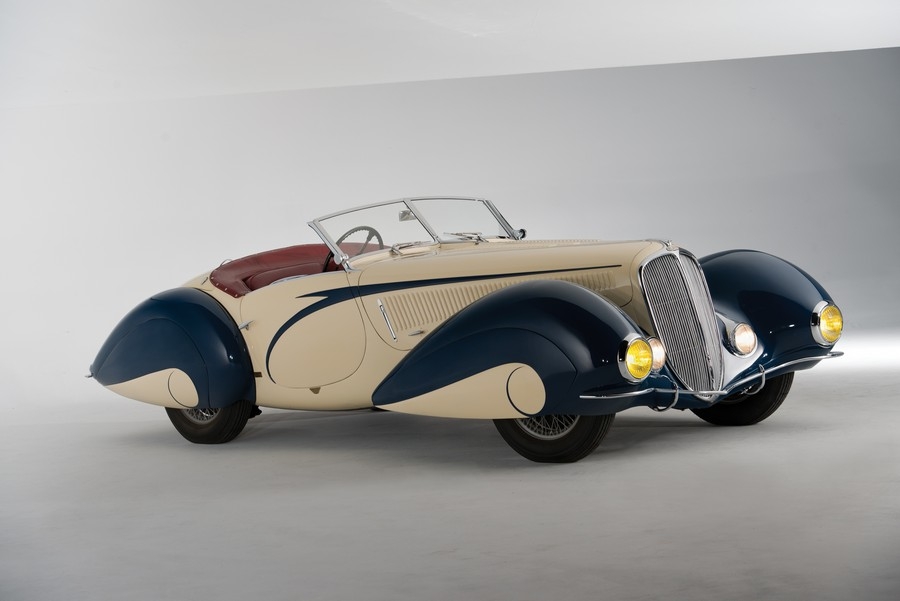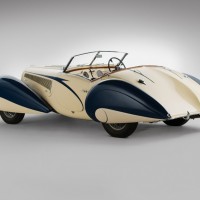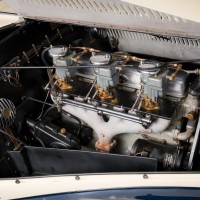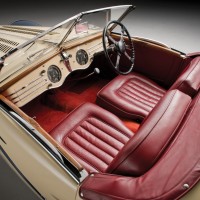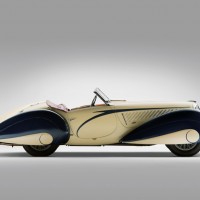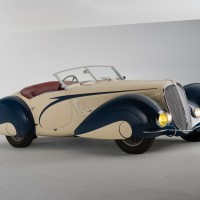SCM Analysis
Detailing
This ex-Malcolm Pray Delahaye 135 roadster sold for $6.6 million with commissions at RM Auctions’ Amelia Island, FL, sale on March 8, 2014. This is a serious amount of money for a collectible car that your neighbor who “collects cars” has never heard of.
However, the transaction offers three points of interest worth considering. But first, a little history:
France in the 1930s possessed a number of manufacturers whose cars now inhabit the upper reaches of the collector car universe — most notably Talbot, Delahaye, Delage (owned by Delahaye subsequent to 1935), Bugatti, and Hispano-Suiza.
Despite the ravages of the worldwide Great Depression, this was the golden age of French coachbuilding. The general thrust of the French industry at this time was on producing cars of style and comfort — and of solid performance without resorting to exotic mechanical mechanisms. The worldwide economic slump had inhibited French industry’s investment appetite, thereby placing a premium on clever use of standard components to make extraordinary cars.
While Bugatti and Hispano cut against this grain with their overhead-cam architecture, light alloy castings, and in the case of some of the cars from Molsheim, supercharging, they relied largely on design traditions that had been developed in the booming 1920s. Really clever engineering in the 1930s was reserved for mass marketers such as Citroën, with their front-wheel-drive “traction avant.” Consequently, this flowering of French coachbuilding was based on domestic cars whose fine performance arose from the most economic of means.
Something sportif
Our subject Delahaye, 48661, exemplifies this trend. Legend says that Charles Weiffenbach, Delahaye honcho, was so piqued by Ettore Bugatti telling him that Delahaye cars, though well conceived, were utterly boring and lackluster that he charged young engineer Jean François to come up with something “sportif.”
Based on the 1933 Type 134 “Superluxe,” the Type 135 was unveiled at the Paris Salon in 1934. The new 135 featured a rigid, lightweight, lowered chassis, comfortable and compliant suspension and a light, powerful 6-cylinder, 3¼-liter, push-rod-actuated, overhead-valve, non-crossflow engine.
In an economy move, the cast-iron monobloc had been taken from Delahaye’s commercial and industrial truck line — whose flashiest products were fire engines. But no matter, the 135 proved to be a hit due to its sparkling performance and fine road manners. Subsequent high-performance 3,557-cc, three-carburetor engines made 120 horsepower for sport applications. Compared with the likes of Bugatti’s Type 57 with its 3-liter, double-overhead cam, inline 8 cylinder engine with optional supercharging, Delahaye’s motor was pretty thin gruel — on paper.
Given the proclivity for beam axles and cart springs at Bugatti, the Delahaye chassis’ independent front suspension with transverse leaf-spring lower control member comes off on paper somewhat better. Its manners over cobblestones or other bumpy surfaces proved infinitely superior in practice. Nevertheless, the performance of the top-line sports cars of the period was largely on a par. Yet consider Delahaye’s 1st, 2nd and 4th at Le Mans in 1938, their 2nd and 3rd at the 1936 Mille Miglia, their Monte Carlo Rallye victory and their absolute lap record at the Irish TT. These were cars with serious competition capability. Boxed chassis members with welded floors made for excellent handling, while the iron 6-cylinder engine’s race-tuned 160 horsepower provided competitive potency.
In a serendipitous public-relations coup, a Delahaye 135 won Autocar’s “Fastest Road Car” competition held at the Brooklands circuit, where it bested a 4-liter Talbot-Lago and a 2900 8C Mille Miglia Alfa among others. Today, a high-performance 135 Delahaye is one of the best pre-war “grand routiers” for vintage touring.
Solid performance married to unreal design
Our subject Delahaye is very special in that it is one of approximately 30 competition court (short) chassis built. These rather mysterious cars may have been “homologation specials” assembled upon special order out of race-department parts bins. Six such cars are thought to have survived.
Now fitted with an MS (Modifié Speciale) engine — which appears to have been installed at the factory in 1939 — 48661 enjoys the ultimate engine development that switched the three siamesed exhaust ports for the intakes and the six intake ports for the exhaust. If it is fitted with conventional bodywork, we could expect a 135 Competition Court to command somewhere between $1 million and $1.5 million, which is pretty good money for the truck-related engine and simple chassis.
So, our first observation: Pedestrian architecture is no impediment to desirability if the car has real performance and abundant competition credentials. The Shelby Cobra is a modern-day example of this phenomenon.
But that’s not all you get with our subject. In our Delahaye we have a noteworthy example of a no-holds-barred Figoni design informed by Georges Hamel. This coachwork represents Delahaye’s equivalent of a Parisian designer’s edgy runway couture.
Such collections are not created as major money spinners — despite the astronomical prices of the pieces. They are, more importantly, image builders for the design house, so premium prices can be obtained from the mass ready-to-wear market. And so it is true here as well. Very few Delahaye buyers wanted to own a truly radical Figoni design. Only 11 Paris Salon style cars were produced — of which the Pray car is number seven.
The triumphant unveiling of this series in 1936 brought instant notoriety to Figoni. Fittingly, that Salon show car went to the Aga Khan. One has only to look at our Delahaye to realize that a shy person need not own one of these fantasies, and that further, such voluptuous enclosed wings on all four wheels present some real usability issues as well.
In essence, Figoni’s radical design established his ultimate reputation for avant-garde, if not overblown, style. He nurtured this with subsequent over-the-top designs, such as his post-war narwhal body with its peculiar proboscis. Indeed, Figoni design has become the quintessence of 1930s French coach design as seen from today’s perspective.
All this brings us to our second observation: Climactic design, the ultimate expression by a famous and influential designer, will always command a huge premium.
Unbeatable ownership history
Great and iconic coachwork, special high-performance “homologation special” chassis, the latest, probably factory-blessed, MS engine, a well-known reputation for “tireless speed” and reliability is further potentiated by Malcolm Pray’s 50-year ownership.
Shown at countless concours and extensively toured in the United States and Europe, 48661 is an example of an important car of great originality with impeccable provenance.
We are currently experiencing a white-hot market for really good cars. Given world conditions, most thoughtful collectors who own superior collectibles are standing pat, and only a lamentable death brings such cars to the market. That is the case here.
Our third observation: Cars cosseted in the bosom of their owners for generations — yet allowed to be seen by the world as they age gracefully and perform reliably — become the trophy acquisitions for knowledgeable and well-heeled collectors. I rummaged through my library as I was researching 48661 and came across a small book created by Pray’s wife, Natalie, titled “Malcolm’s French Mistress.” It is a poignant paean to one man’s life with his beloved car. Money can’t buy that. Fairly bought. ♦
